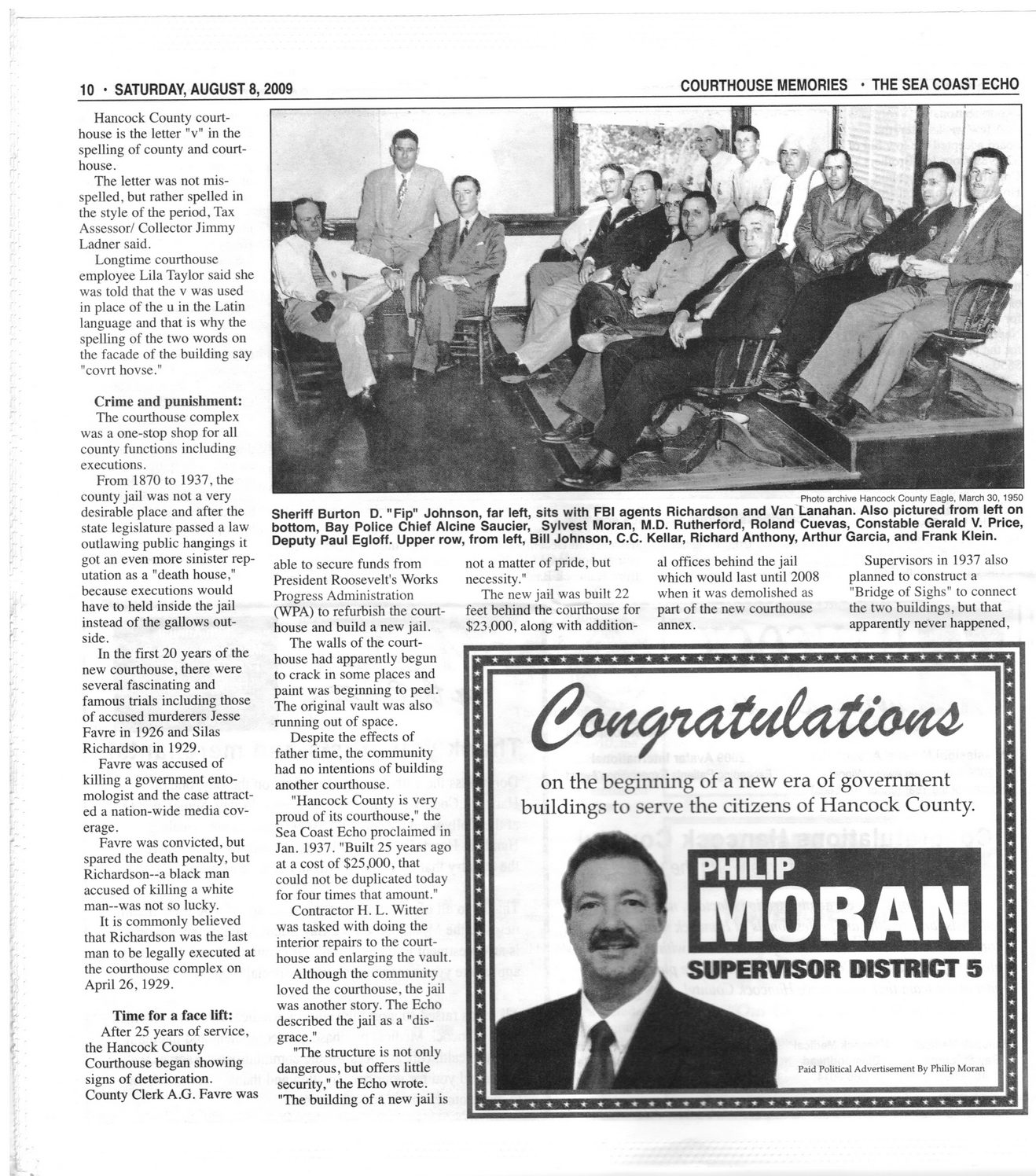This text was obtained via automated optical character recognition.
It has not been edited and may therefore contain several errors.
10 • SATURDAY, AUGUST 8, 2009 COURTHOUSE MEMORIES • THE SEA COAST ECHO Photo archive Hancock County Eagle, March 30, 1950 Sheriff Burton D. "Fip" Johnson, far left, sits with FBI agents Richardson and Van Lanahan. Also pictured from left on bottom, Bay Police Chief Alcine Saucier, Sylvest Moran, M.D. Rutherford, Roland Cuevas, Constable Gerald V. Price, Deputy Paul Egloff. Upper row, from left, Bill Johnson, C.C. Kellar, Richard Anthony, Arthur Garcia, and Frank Klein. Hancock County courthouse is the letter "v" in the spelling of county and courthouse. The letter was not misspelled, but rather spelled in the style of the period, Tax Assessor/ Collector Jimmy Ladner said. Longtime courthouse employee Lila Taylor said she was told that the v was used in place of the u in the Latin language and that is why the spelling of the two words on the facade of the building say "covrt hovse." Crime and punishment: The courthouse complex was a one-stop shop for all county functions including executions. From 1870 to 1937, the county jail was not a very desirable place and after the state legislature passed a law outlawing public hangings it got an even more sinister reputation as a "death house," because executions would have to held inside the jail instead of the gallows outside. In the first 20 years of the new courthouse, there were several fascinating and famous trials including those of accused murderers Jesse Favre in 1926 and Silas Richardson in 1929. Favre was accused of killing a government entomologist and the case attracted a nation-wide media coverage. Favre was convicted, but spared the death penalty, but Richardson—a black man accused of killing a white man—was not so lucky. It is commonly believed that Richardson was the last man to be legally executed at the courthouse complex on April 26, 1929. Time for a face lift: After 25 years of service, the Hancock County Courthouse began showing signs of deterioration. County Clerk A.G. Favre was able to secure funds from President Roosevelt's Works Progress Administration (WPA) to refurbish the courthouse and build a new jail. The walls of the courthouse had apparently begun to crack in some places and paint was beginning to peel. The original vault was also running out of space. Despite the effects of father time, the community had no intentions of building another courthouse. "Hancock County is very proud of its courthouse," the Sea Coast Echo proclaimed in Jan. 1937. "Built 25 years ago at a cost of $25,000, that could not be duplicated today for four times that amount." Contractor H. L. Witter was tasked with doing the interior repairs to the courthouse and enlarging the vault. Although the community loved the courthouse, the jail was another story. The Echo described the jail as a "disgrace." "The structure is not only dangerous, but offers little security," the Echo wrote. "The building of a new jail is not a matter of pride, but necessity." The new jail was built 22 feet behind the courthouse for $23,000, along with addition- al offices behind the jail which would last until 2008 when it was demolished as part of the new courthouse annex. Supervisors in 1937 also planned to construct a "Bridge of Sighs" to connect the two buildings, but that apparently never happened,

Hancock County Courthouse Courthouse-Memories-SCE-Special-2009-(08)